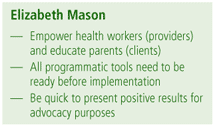WHO NEWS
WHO's strategy on Integrated Management of Childhood Illness
Elizabeth Mason, Director of WHO's Department of Child and Adolescent Health and Development (CAH), says that since WHO launched the Integrated Management of Childhood Illness (IMCI) strategy in 1995 it has been implemented in more than 100 countries. In some countries it has already led to improvements in child survival and health. The programme started in response to a request from countries to expand the remit of the management of diarrhoeal diseases and acute respiratory infections to cover all the major life-threatening conditions of childhood. It is based on the idea that health workers need to look at the child as a whole.

Q: What are the practices that helped to make IMCI a success?
A: IMCI is a very simple tool based on evidence, and it simplifies the approach to managing the child while at the same time considering the child as a whole. It also includes communications skills between the health worker and the mother, so that the health worker feels empowered to advise parents better, so that the parents are more likely to understand and adhere to the advice. A lot of the feedback on IMCI has been on health worker skills and confidence: confidence in their decision-making, and skills to make the best decision for that child. Whether the best decision is to give or not give an antibiotic, or to refer or counsel the mother health workers actually have a systematic review process to follow. They can make a decision based on a clear set of well-defined instructions, and that decision leads them to the correct action. IMCI guidelines and materials are adapted to the epidemiological, political, and social environment of a country. The guidelines thus meet a country's specific needs in terms of illnesses (e.g. malaria or HIV), drug policy (which drugs are available at which level of health facility) and organizational structure. The fact that it has been essential to build from the beginning and continually nurture partnerships with other principal actors in child health creates a stronger technical and funding base, and helps develop harmonious assistance to countries.
Q: What lessons did you learn for the future, when implementing this programme?
A: One key lesson was that you need to have the programmatic tools at the same time as the training tools. One of the initial criticisms was that IMCI was just a training programme, since the other programmatic areas were not developed well enough initially. Another key lesson was in our presentation of IMCI to countries. For example, the training of health workers is done in a fairly intensive 11-day course. For the health worker, it is a short time to learn a great deal of material. For the decision-makers, it is a long time to take health workers from their posts. For the funders, it is expensive. Overall, you have a mixture of interests. In the packaging, we were focused more on the content than on an explanation of why that length of time is necessary. Having all programmatic tools ready may have been a more successful way of ensuring agreement among the decision-makers and the funders. In addition, we need to be quicker to present positive results. Although we embarked on a very comprehensive multi-country evaluation of IMCI, we didnt pay sufficient attention to more punctual evaluation and feedback that would give results we could communicate to the ministries of health and to partners. I would do that differently in future. 
